
About UsThe Numismatic Bibliomania Society is a non-profit organization promoting numismatic literature. For more information please see our web site at coinbooks.org SubscriptionsThose wishing to become new E-Sylum subscribers (or wishing to Unsubscribe) can go to the following web page link MembershipThere is a membership application available on the web site Membership Application To join, print the application and return it with your check to the address printed on the application. Membership is only $15 to addresses in the U.S., $20 for First Class mail, and $25 elsewhere. For those without web access, write to: David M. Sundman, Secretary/TreasurerNumismatic Bibliomania
Society AsylumFor Asylum mailing address changes and other membership questions, contact David at this email address: dsundman@LittletonCoin.com SubmissionsTo submit items for publication in The E-Sylum, just Reply to this message, or write to the Editor at this address: whomren@coinlibrary.com
BUY THE BOOK BEFORE THE COINYou won't regret it! |
- WAYNE'S WORDS: THE E-SYLUM MAY 24, 2009
- LAKE BOOKS 98TH MAIL BID SALE CLOSES MAY 26, 2009
- MAY 2009 ISSUE OF THE BOOKSHELF FIXED PRICE LIST AVAILABLE
- NEW BOOK: SOCIALIST REPUBLIC OF VIET NAM COINS AND CURRENCY
- NEW EDITION: WORLD PAPER MONEY MODERN ISSUES, 1961-PRESENT
- SELECTED LOTS FROM THE JUNE 13, 2009 SKLOW NUMISMATIC LITERATURE SALE
- SOME CHANGES IN THE NUMISMATIC WORLD, SMALL AND LARGE
- DAVID LISOT RETURNS TO FULL TIME NUMISMATIC VIDEO PRODUCTION
- QUIZ ANSWER: NUMISMATIC LITERATURE AND WERNER AMELINGMEIER
- BIBLIOPHILE ON THE FRANKLIN MINT MEDAL CONFIRMED
- NEW YORK TIMES EDITORIAL ON U.S. COINS
- CROWDS GATHERED IN INDIANA FOR RELEASE OF NEW LINCOLN CENT
- ARTICLE LAMPOONS PRESIDENTIAL DOLLAR SERIES
- MINT DIRECTOR DE SAUSSURE'S CHARLESTON HOME RENOVATED
- FAMILY CHARGE COIN STASH UNCOVERED
- PITTSBURGH POLICE CHALLENGE COINS RAISE FUNDS FOR FALLEN OFFICERS
- MORE ON THE GREAT DEPRECIATION
- MORE ON THE AMAZON KINDLE
- MORE ON THE PLINY CHASE CIVIL WAR TOKEN CATALOG
- DICK JOHNSON ON NUMISMATIC DESIGN COPYRIGHT RESEARCH
- JAMAICA TO ISSUE NEW $5,000 BANKNOTE
- ARTISTS SELL PAINTINGS OF ITEMS TO BUY ITEMS THE PAINTINGS DEPICT
- BANK ERROR IN COUPLE'S FAVOR: PAIR ABSCONDS WITH MILLIONS
- FEATURED WEB SITE: THE AMERICAN VECTURIST ASSOCIATION
WAYNE'S WORDS: THE E-SYLUM MAY 24, 2009
 Among our recent subscribers is C. John Ferreri. We now have 1,227 subscribers.
Among our recent subscribers is C. John Ferreri. We now have 1,227 subscribers. Ed Krivoniak writes:
On April 19 you reported no new members and a count of 1229.
On April 26 you reported 6 new members and a count of 1233.
On May 3 you reported 1 new member and a count of 1234.
On May 10 you reported 2 new members and a count of 1224.
On May 17 you reported 3 new members and a count of 1227
So why don't the numbers add up? Well, I don't list every new subscriber because all I really see are email addresses and addresses like "banjolvr51" are hard to translate. People subscribe and unsubscribe all the time and I’m unable to list everyone individually.
Sometimes the system automatically unsubscribes people after their email addresses bounce enough times, and that's what happened to drop the count on May 10th. So the number goes up or down independently of the new subscribers I list each week.
This week we open with updates from numismatic literature dealers Fred Lake and David Fanning, and later I discuss selected lots from David Sklow's upcoming sale. New books this week include Howard Daniel's new Vietnam book and a new edition from Krause of the Modern Paper Money book.
In the news, one numismatic firm changes its name, one loses a namesake and a videographer returns to business full-time. Topics continued from earlier issues include Werner Amelingmeier, Washington Irving, and the very rare Pliny Chase catalog of U.S. Civil War Tokens.
Other topics include the launch of the newest Lincoln Cent, the home of an early U.S. Mint Director, challenge coins, charge coins and barter art. To learn how go shoe shopping without cash money, read on. Have a great week, everyone!
Wayne Homren
Numismatic Bibliomania Society
LAKE BOOKS 98TH MAIL BID SALE CLOSES MAY 26, 2009
 Our 98th mail-bid sale of numismatic literature closes on Tuesday, May 26, 2009 at 5:00 PM (EDT). Your bids may be sent via email, fax or telephone until that closing time. You can view the sale at www.lakebooks.com/current.html
Our 98th mail-bid sale of numismatic literature closes on Tuesday, May 26, 2009 at 5:00 PM (EDT). Your bids may be sent via email, fax or telephone until that closing time. You can view the sale at www.lakebooks.com/current.html Please be advised that our fax number was not operational from Monday, May 11th until Monday, May 18th. If you believe that we may not have received your faxed bids during that time period, please resend or contact us. Good Luck with your bidding !
MAY 2009 ISSUE OF THE BOOKSHELF FIXED PRICE LIST AVAILABLE
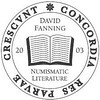
The May issue of The Bookshelf, the fixed price list issued by David F. Fanning Numismatic Literature, has been published. Regular customers will receive copies in the mail (if they haven’t already). The issue is also available on the firm’s Web site at www.fanningbooks.com/Bookshelf3Web.pdf .
The list includes 100 lots of numismatic literature. Highlights include James Mease’s 1834 description of American medals, published in the Collections of the Massachusetts Historical Society. This extremely rare volume is of considerable historical importance as one of the earliest American works written from a numismatic perspective, and is available for $1500.
David F. Fanning Numismatic Literature’s second auction sale closes on June 4. Bids are being received at a good rate, and bidders are encouraged to submit their bids early. Bids may be placed by post, e-mail or phone. David Fanning can be reached at (614) 256-8915 or dfanning@columbus.rr.com. The catalogue is available on the firm’s Web site at www.fanningbooks.com, and a handful of hard copies remain available
NEW BOOK: SOCIALIST REPUBLIC OF VIET NAM COINS AND CURRENCY
 The catalog is the Socialist Republic of Viet Nam Coins and Currency and it covers the financial instruments issued in Viet Nam from 1978 to date, to include, legal tender coins and notes, limited circulation bank checks, tokens, foreign exchange certificates, tokens, bonds, etc., etc.
The catalog is the Socialist Republic of Viet Nam Coins and Currency and it covers the financial instruments issued in Viet Nam from 1978 to date, to include, legal tender coins and notes, limited circulation bank checks, tokens, foreign exchange certificates, tokens, bonds, etc., etc. There are also checklists at the back for collectors to inventory their collections. It is printed on the same high quality paper and cover as the annual Japanese Numismatic Dealers Association catalog, but in a slightly larger format.
It will sell for 250,000 Dong in Ho Chi Minh City at Saigon Coins & Stamps and the email there is SaigonCoin@cs.com. There is not yet a price for it in the USA and elsewhere because the shipping costs from Viet Nam to the USA have to be added to the calculation before it can be determined. There are two dealers in the USA who will be resellers. The first is Scott Semans at www.CoinCoin.com. And the second is Sema at www.ArtofHanoi.com.
They do not yet have their copies or a price so buyers can only notify them they are interested in purchasing it and to be notified once their shipment arrives. It will be much more efficient to order a copy from the two dealers because I am constantly traveling and not always available to ship them.
I will be selling the card cover version from the USA and can be contacted at HADaniel3@msn.com. But I am also planning to make about twenty-five hardcover versions of the catalog as done for my last catalog; Democratic Republic of Viet Nam Coins and Currency, which covers their issues from 1945 to 1978. This version will be for those bibliomaniacs wanting a hardcover for their library. Please remember, there is not yet a date and price either versions of the new catalog.
NEW EDITION: WORLD PAPER MONEY MODERN ISSUES, 1961-PRESENT
Scott Tappa of Krause Publications forwarded the following press release. He writes: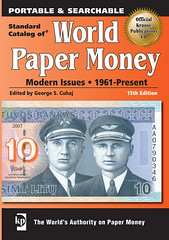 As the largest and most comprehensive English language guide to world bank notes issued between 1961 to the present, the Standard Catalog of® World Paper Money Modern Issues, 1961-Present (available now from Krause Publications) serves a segment of the numismatic hobby which continues to grow in popularity and market activity.
As the largest and most comprehensive English language guide to world bank notes issued between 1961 to the present, the Standard Catalog of® World Paper Money Modern Issues, 1961-Present (available now from Krause Publications) serves a segment of the numismatic hobby which continues to grow in popularity and market activity. This 1,112-page 15th edition features new listings and items that reflect recent developments and new varieties and discoveries. The release of new European Union issues, and upward market movement of segments such as early Queen Elizabeth II notes, high-grade early issues of African nations and Australian issues are all reflected in the details and listings of this comprehensive catalog. In addition, readers also will find numerous previously unlisted Specimen issues.
This new edition also includes a free CD featuring the complete contents of the book, in an easy-to-search PDF format which also allows readers to enlarge pages by 400%. A great tool for close-up inspection of notes and easier viewing of listings, the CD also provides another resource option for collectors and dealers during shows and while researching the Web for auctions. The CD is also available for purchase separately.
With more than 19,000 variety listings, pricing in three condition grades, 12,000 illustrations of bank notes and several appendices to assist with conversion and grading, this is the one stop resource to the modern paper money market.
For more information visit www.shopnumismaster.com .
Author George S. Cuhaj is a 15-year veteran of Krause Publications’ Numismatic Catalog Division, where he is also the editor of the Standard Catalog of World Coins series. Cuhaj hails from New York City, where he was previously on staff with the American Numismatic Society, Stack’s Rare Coins and R.M. Smythe & Co.
THE BOOK BAZARRE
SELECTED LOTS FROM THE JUNE 13, 2009 SKLOW NUMISMATIC LITERATURE SALE
The Deluxe Numbered Limited edition No. 82 of 182 presented, 23 full tone photographic plates with tissue guards, oblong quarto format, purple leatherette covers, gilt. {also included} THE FREDERICK B. TAYLOR COLLECTION SALE. March 26-28, 1987, 317pp. 391 lots, prl, 4to, pictorial card covers.
Charles Davis writes in his work American Numismatic Literature, “Issued almost a year after the sale, it contains 23 full tone photographic plates of the obverses and reverses of 541 examples of Vermont (38), Massachusetts (42), New Jersey (118), and Connecticut (343) coinage, its oblong quarto format is reminiscent of the Wurtzbach plates of Massachusetts Silver.”
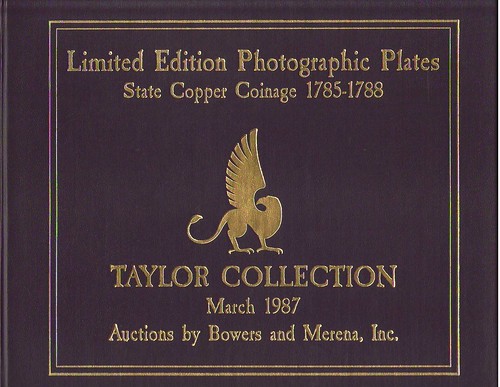
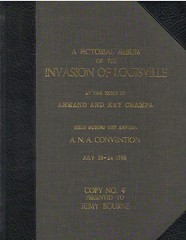 Lot 415 Champa, Armand. A PICTORIAL ALBUM OF THE INVASION OF LOUISVILLE AT THE HOME OF ARMAND AND KAY CHAMPA: HELD DURING THE ANNUAL A.N.A. CONVENTION JULY 23-24 1988: COPY NO. 4 PRESENTED TO REMY BOURNE. Louisville, KY. 1988, 28 photographic insert pages, 155 color 3 ½ x 5 inch photographs & 2 color 8 x 10 inch photographs, 4to. Special Limited Edition Presentation Binding, Half Black Leather with grey cloth, gilt covers, gilt spine with five raised hubs.
Lot 415 Champa, Armand. A PICTORIAL ALBUM OF THE INVASION OF LOUISVILLE AT THE HOME OF ARMAND AND KAY CHAMPA: HELD DURING THE ANNUAL A.N.A. CONVENTION JULY 23-24 1988: COPY NO. 4 PRESENTED TO REMY BOURNE. Louisville, KY. 1988, 28 photographic insert pages, 155 color 3 ½ x 5 inch photographs & 2 color 8 x 10 inch photographs, 4to. Special Limited Edition Presentation Binding, Half Black Leather with grey cloth, gilt covers, gilt spine with five raised hubs. This is the very Limited Numbered Edition being No. 4 and presented to Remy Bourne; the front cover is lettered in gilt with full title and presentation information; the front endpaper is inscribed: To my good friend Remy Bourne this album is with my compliments, Enjoy, (signed) Armand Champa, Dec 13, 1988; the binding was done by Alan Grace (Champa’s official binder); the distribution list of the 14 presentation editions is slipped in the first photo sheet, an invitation is also slipped in the third sheet;
I was lucky to be present for the affair, one of the highlights of my numismatic life. Armand was a generous and gracious host. Although his numismatic library was the star of the event, the participants were the true highlight of the day. Yes, John Ford stole the show with his endless numismatic stories, but even he couldn't dim the lights of the attending numismatic luminaries. I made several friendships that day that have lasted a lifetime. Thanks, Armand!
-Editor
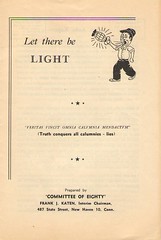 Lot 577 Katen, Frank J. LET THERE BE LIGHT. New Haven, Conn. Circa 1950. 24pp. 8vo. Original self covered.
Lot 577 Katen, Frank J. LET THERE BE LIGHT. New Haven, Conn. Circa 1950. 24pp. 8vo. Original self covered. A booklet prepared by “Committee of Eighty” containing reprints of Katen’s Koin Kapers that appeared in his auction catalogs 1949-1950; Katen was extremely out spoken against the ANA management, a stand that led to him being expelled; later (many years) he would be exonerated and his Life Membership reinstated; a very interesting booklet worth reading and very scarce and seldom available;
SOME CHANGES IN THE NUMISMATIC WORLD, SMALL AND LARGE
“The Company has undergone significant changes in the past few years, and our new name reflects those developments. Spectrum Group offers nearly 20 years of brand recognition as the name of our key rare coin wholesale subsidiary, and also conveys the breadth and scope of our collectibles and trading businesses, which now encompass precious metals, wine, rare U.S. and foreign coins, U.S. and foreign currency, U.S. and foreign stamps, and arms and armor.”
In connection with its name change, the Company’s trading symbol will also be changed, which is expected to occur within two to four weeks.
Spectrum Group is a consolidated global collectibles network. The Company is a leading auctioneer of stamps, coins, arms, armor and militaria, and other memorabilia, targeting both collectors and dealers. Spectrum is also a merchant/dealer of certain collectibles and trader of precious metals. The Company's collectibles offerings span the modest to ultra high-end price spectrum. Spectrum conducts its operations in two business segments: collectibles and trading.
Spectrum Group’s collectibles companies focused on philately are auction houses H.R. Harmer of Irvine, California, Corinphila Auktionen of Zurich, Switzerland, Heinrich Köhler Auktionshaus of Wiesbaden, Germany, and John Bull Stamp Auctions, Ltd of Hong Kong. Spectrum Group’s collectibles companies in the numismatics field include Bowers and Merena Auctions (rare coin and currency auction house), Ponterio & Associates (world and ancient coins and currency auction house), Teletrade (online coin auctions) and Spectrum Numismatics International (wholesale rare coin dealer), all based in Irvine, California. Spectrum Group also owns Greg Martin Auctions, which is engaged in the sale by auction of arms, armor and militaria, and will shortly be expanding into wine auctions.
The trading activities of Spectrum Group are conducted through A-Mark Precious Metals, one of the largest private sellers of bullion coins and bullion gold, silver and platinum to the wholesale marketplace. A-Mark’s subsidiary Collateral Finance Corporation, which is the Official Numismatic Lender of the American Numismatic Association, provides financing on a wide array of bullion and numismatic products.
To read the complete Escala Press Release, see: Escala Group, Inc. Announces Name Change (www.businesswire.com/news/google/20090522005070/en)
Independent sources in a position to know have confirmed his exit. One E-Sylum reader I contacted writes:
 Larry is Harvey Stack's son, Susan Stack's brother, nephew to the late Norman and Ben and grandson of founders Morton & Joseph. For the past 10 years or more, Larry was the controlling power at Stack's and was singularly responsible for bringing John J. Ford's estate to auction based on his longstanding friendship with Ford and Stack's relationship with researcher/cataloguer Mike Hodder, who was also close with Ford.
Larry is Harvey Stack's son, Susan Stack's brother, nephew to the late Norman and Ben and grandson of founders Morton & Joseph. For the past 10 years or more, Larry was the controlling power at Stack's and was singularly responsible for bringing John J. Ford's estate to auction based on his longstanding friendship with Ford and Stack's relationship with researcher/cataloguer Mike Hodder, who was also close with Ford. Larry adopted Ford's and Bowers' belief and practice in issuing informative, high quality auction catalogues which proved to be invaluable references years after the auctions occurred.
DAVID LISOT RETURNS TO FULL TIME NUMISMATIC VIDEO PRODUCTION
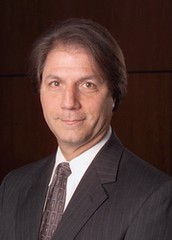 David Lisot has announced the resumption of his full time video production business. He specializes in creating programming that promotes numismatics and collecting He will be based in Dallas, Texas, along with offices in Boulder, Colorado.
David Lisot has announced the resumption of his full time video production business. He specializes in creating programming that promotes numismatics and collecting He will be based in Dallas, Texas, along with offices in Boulder, Colorado.He is executive producer for the website Cointelevision.com that offers free streaming video news and information to the numismatic hobby featuring interviews and current events from major coin conventions.
He continues to produce lectures, presentations and news clips for the major coin collector organizations including the American Numismatic Association, Central States Numismatic Society, Early American Coppers, Florida United Numismatists, Professional Numismatists Guild, as well as others. He recently concluded an agreement with the Greater Houston Coin Club to produce television commercials and advertising for the Money Show of the Southwest being held in December in Houston, Texas.
According to Lisot, the numismatic industry needs streaming video on the Internet to stay competitive. As the coin market adjusts to the current financial situation this new technology is needed to attract new clients and collectors.
Lisot was one of the pioneers in developing streaming video on the Internet. DVDs of his productions are available on Coinvideo.com. He continues to offer his services to dealers, auction companies and collector groups to bring affordable video production to the numismatic marketplace.
David can be contacted at:
1-800-876-2320
972-644-8040
dlisot@cointelevision.com
QUIZ ANSWER: NUMISMATIC LITERATURE AND WERNER AMELINGMEIER
Alan V. Weinberg writes:
Karl Moulton writes:
George Kolbe writes:
Werner Amelingmeier is prominently mentioned, I believe, in earlier issues of The Asylum, both by Ford and by Harry Bass. Back in the 70s, Werner sent me tons of numismatic literature on consignment, via the good offices of John Ford. Lots of Wayte Raymond publications and a wide variety of other works. I have always assumed that it was the remaining Ford Numismatic Publications stock.
BIBLIOPHILE ON THE FRANKLIN MINT MEDAL CONFIRMED
In response to Pete Smith's query about this Franklin Mint medal, David Gladfelter reasoned that it must be author Washington Irving. Arthur Shippee writes: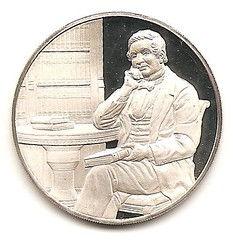
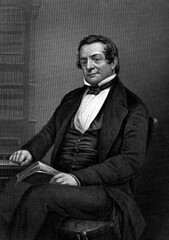
NEW YORK TIMES EDITORIAL ON U.S. COINS
Michael is quite accurate in his review of all the past multiple coin issues, dominated, of course, by the statehood quarter series. It returned $3 billion in seigniorage, he states, to the Treasury coffers from the total sales over the ten-year period. I don't doubt that figure, but it is the first time I have seen it in print.
He would like to see a return of Lady Liberty to standardize our coin designs and hold to that design for at least a decade. "It was once common to portray Liberty," he wrote, "personified in female form, on our coins. Imagine the return of this figure, grown wiser and reflective after her absence, evoking confidence that our nation will endure any hardship and meet any challenge. Then, maybe our coins will once again become respected national symbols."
I concur, but I was offput by the Times headline, "Change We Don't Need." I was expecting a directive to abolish the cent after 2010. It's okay to make a $3 billion profit from U.S. citizens off of quarters, but it is not okay to save $300 million a year to abolish an unnecessary cent?
Be that as it may, it was an excellent editorial. Take a bow, Michael.
As for eliminating the cent, I wouldn't be surprised to see it happen one day, but old habits are hard to break and human nature is never on the side of change. A week ago I was on the road traveling to visit family and before heading out of town I stopped in a nearby supermarket to satisfy a craving for a donut, as if my butt didn't take up enough room in the driver's seat already. I picked out a nice glazed donut and headed to the self-checkout, another one of those newfangled things old geezers like me find a pain.
The sale rang up at 59 cents. I put two quarters and a dime into the coin slot, and the machine rounded it up to 60 cents and said thank you very much. I said "Where's my penny!!? I want my penny!! Gimme my g*dd*amn penny, you miserable &*&%$#!!" -Editor
These critics have a point. This year we have even more coin programs featuring rotating designs. For Lincoln’s 200th birthday, four different reverse (tails) designs were produced for the penny. American Indians will be honored with a new series of dollar coins. And six quarters will be issued featuring the District of Columbia as well as the territories of Guam, American Samoa, the Virgin Islands, Puerto Rico and the Northern Mariana Islands.
As a result of all this, this year we will have more coin series with rotating designs than series with permanent designs. We may find ourselves thankful for the constancy of the Jefferson nickel, the Roosevelt dime and the Kennedy half-dollar, which is no longer even issued for circulation.
Coins are a medium of exchange. They should be relatively standard, universally identifiable units of money. On a deeper level, coins are also representations of the country that issues them. Our currency has become a shifting, unidentifiable mess that tries to recognize everything and ends up symbolizing nothing.
The best remedy would simply be to overhaul all our standard coin designs. Redesign each denomination across the board, and leave the new designs in place for at least a decade. These redesigned coins should be contemporary in nature but timeless in theme, and unmistakable objects of art.
To read the complete article, see: Change We Don’t Need (www.nytimes.com/2009/05/21/opinion/21Zeilinski.html)
CROWDS GATHERED IN INDIANA FOR RELEASE OF NEW LINCOLN CENT
Amid rain, traffic jams and music, nearly 3,000 people showed up for the official release of the new “Indiana” Lincoln penny depicting (on the reverse side) Abe as a Hoosier teenager reading a book while taking a break from rail splitting.

About 800 of those who turned out attended a ceremony inside the Lincoln State Park Amphitheatre featuring speeches, patriotic numbers by choirs, including the Oak Hill Singers from Evansville’s Oak Hill Middle School, a performance by actor Britt Reagan from this summer’s “Lincoln” musical (debuting June 12 at the amphitheater) and remarks by U.S. Mint Director Edmund C. Moy.
Another 1,500 coin enthusiasts stood outside in a quarter-mile-long line — some for up to seven hours — waiting to buy rolls of the new penny after the ceremony.
The line included coin traders from as far as Reno, Nevada, but also a group of Amish residents from the Lexington, Ky., area who hopped a ride in the wee hours Thursday.
Moy said about 20,000 of the shiny new pennies from the Philadelphia mint were brought to Thursday’s festivities in a Brinks truck.

To read the complete article, see: 'Woodstock of Coin' greets the new Lincoln penny (www.courierpress.com/news/2009/may/14/woodstock-coin-greets-new-lincoln-penny/)
ARTICLE LAMPOONS PRESIDENTIAL DOLLAR SERIES
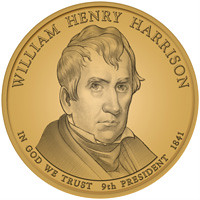 Just when America desperately needs a hero, along comes the most beloved and highly regarded former congressman and U.S. senator of his generation, a man of the people destined to captain our financially fraught ship of state out of the Sargasso Sea of stagflation.
Just when America desperately needs a hero, along comes the most beloved and highly regarded former congressman and U.S. senator of his generation, a man of the people destined to captain our financially fraught ship of state out of the Sargasso Sea of stagflation.If you thought his ascendancy to the nation's highest office was audacious, just imagine the odds that he would one day grace a U.S. coin.
I'm referring, of course, to William Henry Harrison.
Granted, the Mint's $1 presidential series coin -- its latest attempt to wean us from greenbacks -- didn't exactly light up the phone lines when Congress approved it in 2005.
Naturally, the initial offering in 2007 was a snooze. After all, the original George W., as in Washington, is already all over our quarters and the dollar bill. Meanwhile, candidate No. 3 -- Thomas Jefferson, or "T-Jay" in collector lingo -- has long anchored the nickel.
What's so special about this Harrison coin, you ask?
In a word: hope.
The nascent numismatist in me figures that if Harrison can grace our coinage, the whole coin image universe just expanded exponentially. And not just for James Garfield, whose chance at coin immortality was cut tragically short by assassination after just four months in office.
“What's so special about this Harrison coin, you ask? In a word: hope.” Unlike the state quarters program, we can even look forward to some coin controversy in the presidential series. Without the program's inclusiveness, it's hard to imagine a groundswell of support for the likes of Franklin Pierce, James Buchanan or Warren Harding, all perennial doormats in the "best presidents" league.
I'm not sure what my reaction will be when I one day hold a Richard Nixon dollar in my hand.
To read the complete article, see: New coin is 'change' we can believe in (http://www.bankrate.com/finance/personal-finance
/new-coin-is-change-we-can-believe-in.aspx)
MINT DIRECTOR DE SAUSSURE'S CHARLESTON HOME RENOVATED
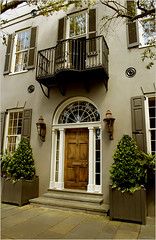 John Dewberry’s town house in Charleston, S.C., was standing when the British captured the city during the Revolutionary War. It was standing when the first shots of the Civil War were fired on Fort Sumter across Charleston Harbor. And it was still standing after an earthquake rocked the city in 1886. When he bought the house in 2003, Mr. Dewberry, a developer in Atlanta, wasn’t about to compete with that kind of history.
John Dewberry’s town house in Charleston, S.C., was standing when the British captured the city during the Revolutionary War. It was standing when the first shots of the Civil War were fired on Fort Sumter across Charleston Harbor. And it was still standing after an earthquake rocked the city in 1886. When he bought the house in 2003, Mr. Dewberry, a developer in Atlanta, wasn’t about to compete with that kind of history. “I told everyone, ‘We’re going to take this house back to the year it was built — 1770,’ ” he said, as horse-drawn carriages filled with tourists passed by outside on a spring Friday.
It took three years, but Mr. Dewberry, 45, the chief executive of Dewberry Capital Corporation, a commercial real estate company, now has the house he envisioned. It is a luxurious 21st-century home within an 18th-century structure, architecturally correct down to the proper hand-tooling of masonry grout.
Brick makers, furniture makers, wrought-iron craftsmen, masons, coppersmiths, stoneworkers, even interns from three colleges — 32 people in all — helped Mr. Dewberry turn back time. They removed every element that wasn’t era-appropriate. What they couldn’t restore, they recreated in minute detail. Four months of research preceded the start of the project.
“John was committed to doing the research necessary to document the structure,” said James Meadors, the owner of Meadors Construction, which specializes in restoring historic architecture. “He wanted to be the current steward of the house and preserve it.”
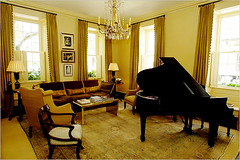 Mr. Dewberry searched for eight years before settling on the three-story house on Meeting Street, a few blocks from Charleston’s waterfront. It had languished on the market, and for good reason. While it had a pedigree, having been the home of Henry William de Saussure, a director of the United States Mint under George Washington, it had also been a corner store for 100 years. Several ill-advised renovations later, the house needed a buyer with patience and deep pockets. Mr. Dewberry bought it for $1.5 million.
Mr. Dewberry searched for eight years before settling on the three-story house on Meeting Street, a few blocks from Charleston’s waterfront. It had languished on the market, and for good reason. While it had a pedigree, having been the home of Henry William de Saussure, a director of the United States Mint under George Washington, it had also been a corner store for 100 years. Several ill-advised renovations later, the house needed a buyer with patience and deep pockets. Mr. Dewberry bought it for $1.5 million. Mr. Dewberry’s primary home in Atlanta is a ranch house retooled to resemble a mountain lodge, but as a history buff, he was enchanted by Charleston’s past. “I always said, ‘If I do well enough, I’d love to have a house in downtown Charleston,’ ” he said.
To read the complete article, see: The Look of Then, the Comforts of Now (www.nytimes.com/2009/05/22/greathomesanddestinations/22Away.html?hpw)
THE BOOK BAZARRE
FAMILY CHARGE COIN STASH UNCOVERED
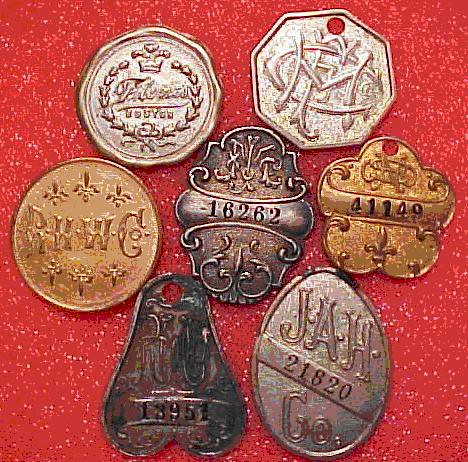
These are charge coins. Before plastic credit cards, fine department stores would extend credit on account and issue coins designed to fit on a key chain or by tucked away in a women’s purse so that she could go shoe shopping without cash money. They were issued by upscale establishment through the 1940s until charge-a-plates and credit cards took over. My family only paid cash back then, so these were not anything I’d have seen.
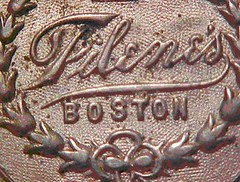 From the upper left you see Filene’s of Boston, the original department store whose seconds go on to fill the discount “basement” establishment. In the center is Jordan Marsh and at left is R.H. White, one of the “big three” department stores in early 20th century downtown Boston. The others CMF Co., in the upper right, JAH Co., in the lower right, and SN Co., far right I don’t know, nor can I read the lower left, heart shaped token.
From the upper left you see Filene’s of Boston, the original department store whose seconds go on to fill the discount “basement” establishment. In the center is Jordan Marsh and at left is R.H. White, one of the “big three” department stores in early 20th century downtown Boston. The others CMF Co., in the upper right, JAH Co., in the lower right, and SN Co., far right I don’t know, nor can I read the lower left, heart shaped token.The reverse of the R. H. White Co. charge coin has a nice eagle and a fairly low number so I expect it is early. There is a society that collects charge cards but little information about charge coins is available on Internet. Steve Alpert's Catalog of Charge Coins at 85 pages in length is said to be the only reference for this type of token. Do E-Sylum readers know of others?
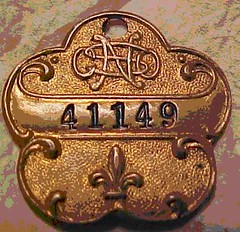
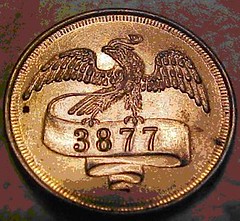
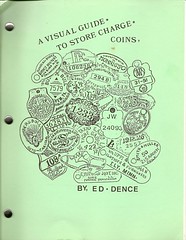
There is a predecessor to Alpert's book. The gentleman who popularized charge coins among token collectors is Ed Dence of Philadelphia. He published several editions of what became his Visual Guide to Store Charge Coins. I wrote the index for one of the early editions.
These are handmade affairs, comprising sets of photocopied or hand-drawn images of charge coins, organized by country, state, city, and issuer. Each was assigned a catalog number according to a system similar to U.S. transportation, Civil War and other tokens. I have the 1994 Fourth Edition (shown here), but don't think I have a copy of the Alpert book yet.
- The "SN" monogram is actually "NS" for Snellenberg's of Philadelphia.
- "JAH" is the James A. Hearn Co, of New York, NY.
- "CMF" has me stumped. I was unable to find it in Dence's book.
PITTSBURGH POLICE CHALLENGE COINS RAISE FUNDS FOR FALLEN OFFICERS
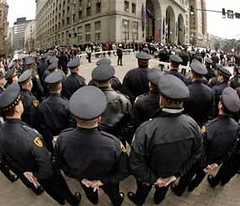 Since April 4, 2009, when an ambush incident in the Stanton Heights section of Pittsburgh took the lives of officers Eric Kelly, Paul J. Sciullo II, and Stephen J. Mayhle, their police family has been not only mourning their loss, but working to help the families of these fallen heroes.
Since April 4, 2009, when an ambush incident in the Stanton Heights section of Pittsburgh took the lives of officers Eric Kelly, Paul J. Sciullo II, and Stephen J. Mayhle, their police family has been not only mourning their loss, but working to help the families of these fallen heroes. In particular, the Pittsburgh PD SWAT team has put together a campaign to raise money for the families through the sale of Pittsburgh Memorial Challenge Coins.
“We wanted to do more than just donate money,” said Detective Chris Marks, who has been in contact with PoliceOne in recent days regarding the fundraising effort. “We wanted something that would memorialize the Officers... and also something for people to have to remember that they too helped out.
Rather than our SWAT team simply donating money to the fund, we came up with the idea of selling these coins instead. We all donated an amount and had these minted. We can then sell them as many times over to continue to contribute, rather than a one time deal,” Marks told PoliceOne.
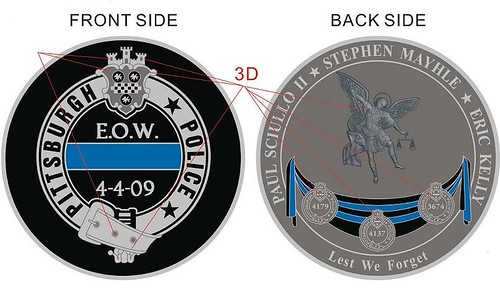
To read the complete article, see: Pittsburgh SWAT uses Challenge Coins to help families of fallen heroes (www.policeone.com/writers/columnists/Doug-Wyllie
/articles/1833000-Pittsburgh-SWAT-uses-Challenge-Coins-to-help-families-of-fallen-heroes/)

MORE ON THE GREAT DEPRECIATION
Briefly, small change of all kinds was so scarce in 1851-52 that foreign silver coins of all nations passed at premiums of up to 40%, and brokers advertised to buy whole Mexican dollars at 3% premium. Polhemus counterstamped heavily during this period. But in 1854 the San Francisco Branch Mint opened, though it did not start coining silver until 1855. As of January 1, 1854, however, the San Francisco bankers refused to accept French francs at more than 20 cents each. But the San Francisco Alta California wrote as late as Oct. 23, 1855,
In 1856, though, the Mint issued 70,000 dimes, 286,000 quarters, and 211,000 halves, and in 1857 another 82,000 quarters and 158,000 halves. These mintages, plus the declining economy, eliminated the coin shortage, and even U.S. dimes sold at a discount (!) from face value before 1860 (Carothers, p. 221). The Indian rupees (passed as half dollars), German coins, single French francs, etc. were never legal tender in the United States in the first place, so their loss of legal tender status in the East had no effect in California.
The "great depreciation" was the result of simple supply and demand; the premiums caused by the great scarcity of change disappeared after the Mint opened, and these foreign coins became worth exchange value only.
MORE ON THE AMAZON KINDLE
Roger Siboni writes:And on the subject of technology and the E-Sylum, I found myself in a hotel room in Los Angeles not too long ago with my MacBookAir and no wireless internet. I ended up reading the Sunday night E-Sylum on my iPhone.
Tim L. Shuck writes:
Digital color catalogs may not be available soon, but apparently the color readers will be. Several websites, wired.com among them, have had recent articles about the new Fujitsu Flepia, a color ebook apparently still being tested. From the Wired website: [http://www.wired.com/gadgetlab/2009/03/worlds-first-co/ ]
"Fujitsu’s Flepia, the color e-book last seen in testing at an upscale Tokyo restaurant, is now available to buy. Don’t get too excited though — even if you’re in Japan, where the Flepia is on sale, it will cost you a whopping ¥99,750, or just over $1000. You get a lot for your money, though. The reader has a an 8" screen which displays 260,000 colors, Bluetooth, Wi-Fi (b and g), a mini USB port and, most important of all, a touch screen (although it comes with a stylus so we expect that it is a resistive touch screen, not capacitive like the iPhone.)
This is completed by a soft, on-screen keyboard (just like the Kindle should have) and a battery life of 40 hours (continuos use — Fujitsu says 2400 page turns). Books are stored on an SD card and can be bought from the online bookstore Papyless.
Curiously, the Flepia seems to be a kind of tablet/e-book hybrid. Along with the book reading software, the device comes loaded with Windows CE 5, meaning support for e-mail, spreadsheets, web browsing and the like. If you view this as a low powered, long life computer instead of a color e-book reader, it starts to look less expensive. The Flepia will start shipping on April 20th."
Second, some thoughts regarding the online Breen Complete Encyclopedia. I am mystified by comments from a few people (exemplified by Susan Headley's statement "Why anybody would want to deprive coin collectors of this wonderful resource is beyond me") that imply the copyright holder to that work should simply give up that ownership. Certainly Escala/ Bowers and Merena could choose that path, but there is no ethical obligation for them to do so.
I own and frequently use the Complete Encyclopedia, but it is a big book. I wouldn't mind having a digital version as well, but this first iteration did not meet my expectations. While researching for a recent description of the Indian Head quarter eagle I wrote for CoinLink I noticed that the designer was in one place listed as "Dela Lyon Pratt", rather than correctly as "Bela Lyon Pratt". There were other text anomalies as well, leading me to believe that the text was scanned, run through word-recognition software, and then not completely proofed (admittedly a big job). I also missed the pagination of the original work but that is perhaps a minor issue.
I don't mean to be overly critical but if this book is to be available digitally there are better ways in my opinion to do so without compromising the original text integrity. Krause has made their Standard Catalog of World Coins available in digital format for a price significantly less than the current asking price of Breen's work; and, beating a familiar drum, it's in pdf, a standard digital format. I would like to see the Complete Encyclopedia available both digitally and in print format, and I would (and did for the print version) pay to own a copy.
MORE ON THE PLINY CHASE CIVIL WAR TOKEN CATALOG
Dave Hirt writes: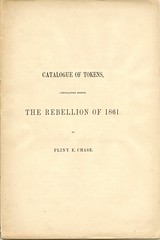 As George Kolbe notes, it is always instructive to be aware of the same copies reappearing on the market, as they tend to obscure true scarcity. My copy did come to me through The Money Tree after Ken's death, so I'm sure it is the example Dave mentions. I don't have a copy of Katen's 77th sale, though. Was there a named consigner?
As George Kolbe notes, it is always instructive to be aware of the same copies reappearing on the market, as they tend to obscure true scarcity. My copy did come to me through The Money Tree after Ken's death, so I'm sure it is the example Dave mentions. I don't have a copy of Katen's 77th sale, though. Was there a named consigner? My copy is NOT the one from the Katen sale of the Fuld library (36th sale, August 15, 1971, lot 679). That copy was "bound and gold stamped". At that time Katen described it as "An exceedingly rare book". It was estimated at $50, but realized only $12. -Editor
DICK JOHNSON ON NUMISMATIC DESIGN COPYRIGHT RESEARCH
Don't hold me to an exact figure, but let's say 25,000 different medals were struck in America before 2000. I would estimate fewer than 500 were protected in some way (by patent or copyright) -- that is 2% of the total. No way could it be even as much as 5%. So the chances of finding even one medal's record is slim at best.
The clerk at Medallic Art Company who handled all the copyright forms occupied the desk just outside my office when I worked there. She would only do this for the most important medals -- or those that would have a large possible sale -- as if someone would replicated a design we paid an artist to prepare. Few companies or organizations would copyright their own medal designs for the reason they saw little need to.
Official Inaugural medals, Society of Medalists, Olympic medals, recent world's fair medals, statehood, some space and sports medals and perhaps a few others were copyrighted. Few others. (Of the 6,000 medals I cataloged at Medallic Art, I would estimate fewer than 200 were copyrighted -- 3%.)
One exception is the American Legion For God and Country Medal. After 40 years the Legion headquarters obtained the legal protection they were seeking. The design patent number 162,975 was added to the edge of all those manufactured in the last quarter century of the 1900s. I suspect some of the local chapters were misusing the medal design.
Protecting medal designs goes back to the 18th century. The first I found was a private French medal of 1791 of Lafayette which was edgelettered: "Monneron (Patente) Se. Vende. A.Paris, Chez." Some private British medal manufacturers would place a registration number with a prefix "RFD" or "Reg No" on the medal. On both French and English medals some patent numbers are found on the edge.
In America an early example was a General Winfield Scott Patriotic Medal of 1861 by C.G. Quilfleldt and J. Lebretton which had all this lettering -- in tiny letters of course -- on the reverse: "Entered According to Act of Congress in the Year 1861 by D.E. Hall in the Clerks Office of the District Court for the Southern District of New York." Whew!
The Copyright law was changed about 1900. Designs were no longer granted patents. Instead it was transferred to the Copyright office at the Library of Congress and granted copyrights. Today they are classed as "VA" visual art.
Tom, if you (or an assistant) goes to the patent office in Alexandria, Virginia, you can do research yourself. After you sign in you can go to the design patents on the mezzanine and search original records as much as you wish. But as I say, don't expect to find much on medals. Otherwise, Good Luck.
JAMAICA TO ISSUE NEW $5,000 BANKNOTE
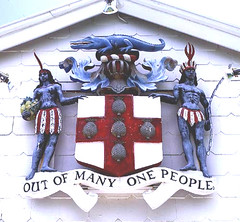 The selection of former prime minister Hugh Shearer's image to grace the new $5,000 note should be of no surprise, based on the central bank's reminder of the policy which affords the honour only to national heroes and to late prime ministers.
The selection of former prime minister Hugh Shearer's image to grace the new $5,000 note should be of no surprise, based on the central bank's reminder of the policy which affords the honour only to national heroes and to late prime ministers.That the announcement should have caused some amount of controversy is also no surprise as this is expected when at least three other names have been proposed, setting the stage for a lively debate, Jamaican style.
What may not have been recalled at the launch of the new bank note is that the successful conversion of our currency from a complicated sterling system to dollars and cents was presided over by Hugh Shearer himself as prime minister in 1969.
No discussion on this issue can be complete without reference to a humorous exchange which took place in 1969, and which is all the more relevant as we reflect on the naming of a currency bill after a politician.
With the new currency about to be launched, Gleaner columnist Morris Cargill, noted for his pungent wit and irreverent view of politicians, published a piece expressing the hope that the finance minister would not name the new currency after any politician as there was nothing he would dislike more "than having to carry a Seaga or a Shearer around in my pocket".
As luck would have it, Seaga appeared on JBC-TV that evening and, in direct reference to Cargill's column, declared he would support a competition to name the new currency, and he himself would enter by suggesting that the lowest denomination, the one-cent coin, be called a Cargill, "because that would mean having a Cargill would be next to having no cents at all".
To read the complete article, see: Back in circulation (http://www.jamaica-gleaner.com/gleaner/20090521/cleisure/cleisure4.html)
ARTISTS SELL PAINTINGS OF ITEMS TO BUY ITEMS THE PAINTINGS DEPICT

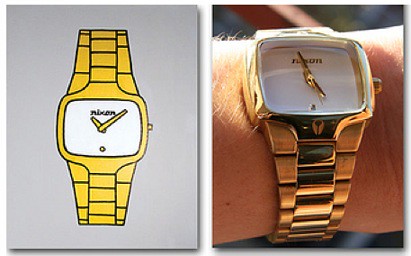
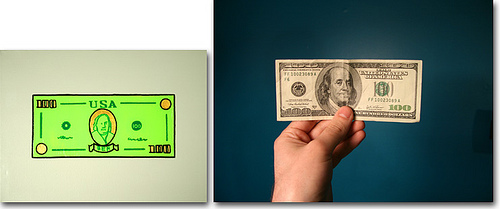
To read the complete article, see: Artists sell paintings of items to buy items the paintings depict (www.boingboing.net/2009/05/21/artists-sell-paintin.html)
BANK ERROR IN COUPLE'S FAVOR: PAIR ABSCONDS WITH MILLIONS
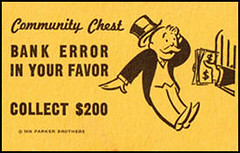 A couple from New Zealand, for example, now have every reason to believe their local bank's motto: making the most of life.
A couple from New Zealand, for example, now have every reason to believe their local bank's motto: making the most of life.The pair.. could hardly believe their luck when they checked their account at Westpac bank on 5 May, hoping to find their request for a NZ$10,900 (£4,000) overdraft had been accepted.
Instead, the bank had deposited 1,000 times that amount: NZ$10m, or around £4m. With so many borrowers around the world constantly being told "no" by their creditors, here, finally, was a bank that liked to say "yes".
While their whereabouts remains a mystery, local reports speculated they may have fled to China or South Korea after transferring as much as NZ$6m to an offshore account.
The local newspaper, the Rotorua Review, said a police official had been sent to China to search for the couple.
To read the complete article, see: New Zealand couple flee after finding £4m in their bank account (www.guardian.co.uk/world/2009/may/21/new-zealand-millionaires-flee-westpac)
FEATURED WEB SITE: THE AMERICAN VECTURIST ASSOCIATION
This week's Featured Web Site is the American Vecturist Associationwww.vecturist.com
